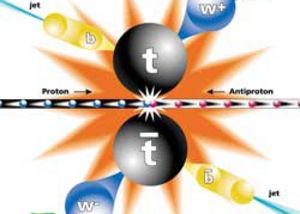Top Quark Analysis
At the LHC, top and antitop quark pairs are created and decay every second. This high event rate makes it possible to accurately determine the properties of the top quark. The mass of the top quark in conjunction with the mass of the W boson and the Higgs boson provide a crucial consistency check for the Standard Model of particle physics. The MPP group makes crucial contributions to measuring the quantities associated with the top quark, the main emphasis being on precision measurements of the top quark mass and combining measurements from different experiments.
Both the top quark and the antitop quark decay into a bottom quark and a W boson. The latter subsequently decays into either two light quarks or a lepton pair such as an electron and an electron anti-neutrino. The quarks form a so-called jet. Physicists make a distinction between three classes of event, depending on the decay channels of the top quark and the antitop quark:
- Di-leptonic: The W bosons from the top quark and the antitop quark decay into two leptons
- Semi-leptonic: One W boson decays into two leptons, the other into quarks
- Hadronic: Both W bosons decay into quarks
Depending on the event class investigated and the number of top quark and antitop quark pairs recorded, different analytical strategies lead to the lowest uncertainty. The MPP group develops these analytical methods in order to always extract the optimal result from the data available. In order to improve precision as much as possible by combining the measurements, the measured values in the different decay channels are selected with as little correlation as possible. In addition, the Monte-Carlo simulations used are to be optimized and the results gained made useful on a broader basis by deconvoluting the detector effects.
These analyses make use of and refine up-to-date evaluation methods, such as multidimensional likelihood maximization, minimization with constraints, kinematic likelihood maximization, pseudo-experiment techniques and deconvolution methods.
